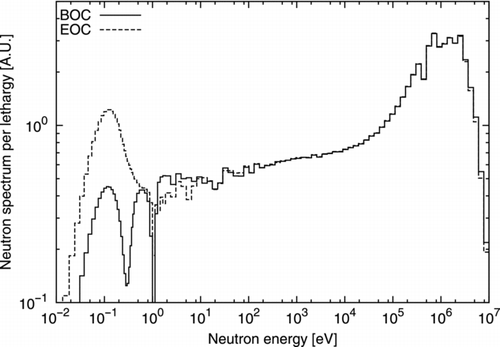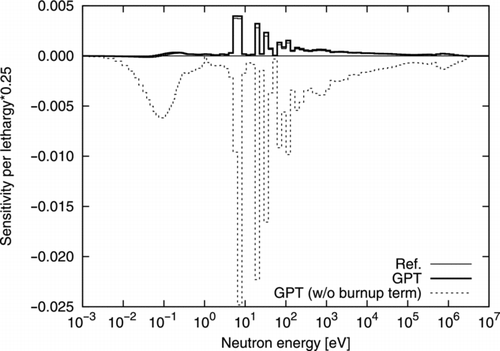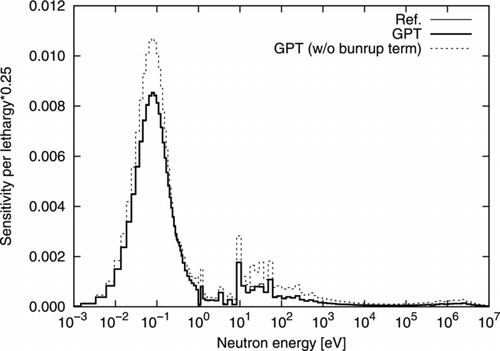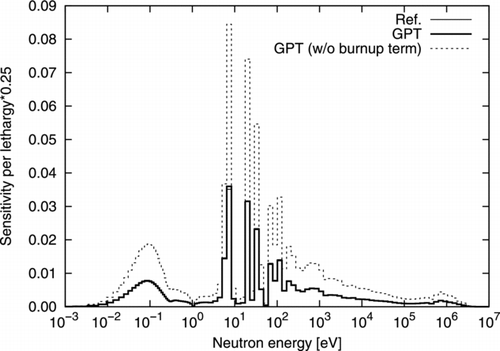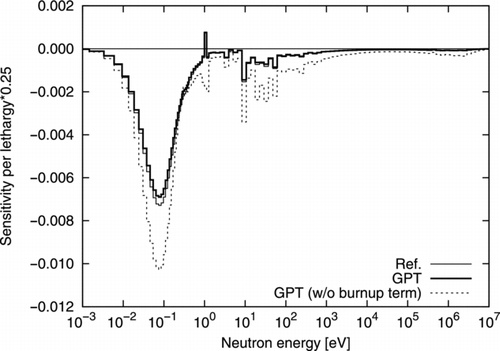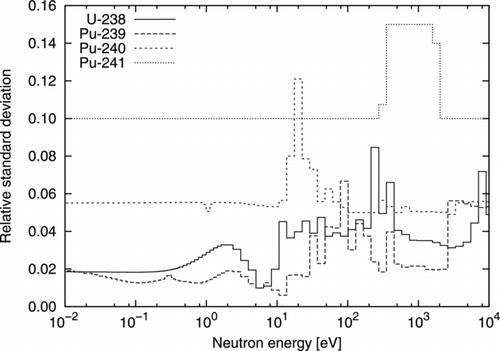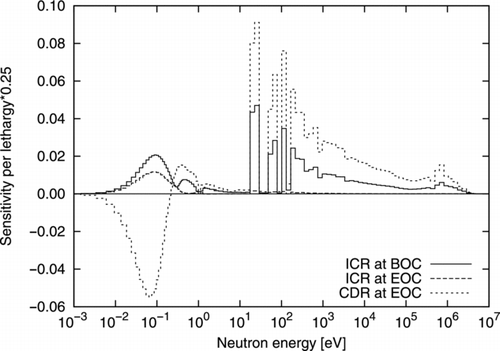Abstract
Neutronic parameter uncertainty induced by nuclear data uncertainty is quantified for several light water reactor fuel cells composed of different combinations of fissile/fertile nuclides. The covariance data given in JENDL-4.0 are used as the nuclear data uncertainty, and uncertainty propagation calculations are carried out using sensitivity coefficients calculated with the generalized perturbation theory for burnup-related neutronic parameters.
It is found that main contributors of nuclear data uncertainty to the neutronic parameter uncertainty are the uranium-238 capture cross section in a uranium-oxide fuel cell, and the plutonium-240 and plutonium-241 capture cross sections and fission spectrum of fissile plutonium isotopes in a uranium–plutonium mixed-oxide fuel cell. It is also found that thorium-232 capture cross section uncertainty is a dominant source of neutronic parameter uncertainty in thorium–uranium and thorium–plutonium mixed-oxide fuel cells. It should be emphasized that precise and detail information of component-wise uncertainties can be obtained by virtue of the adjoint-based sensitivity calculation methodology. Furthermore, cross-correlations are evaluated for each fuel cell, and strong correlations among the same parameters at the beginning of cycle and at the end of cycle and among different parameters are observed.
1. Introduction
Enormous effort has been made to improve models and methodologies for nuclear data evaluations and reactor physics calculations so far, and consequently quite precise physical and numerical models have been realized. Those enable us to better understand the physical behavior of fission reactors, and to drastically improve the prediction capability for reactor neutronic parameters.
Even if the physical theories and numerical models have been greatly sophisticated, calculated reactor neutronic parameters inevitably have their uncertainties to a certain degree. Uncertainty quantification of the calculated parameters is required in order to assign an appropriate margin to those parameters.
The importance of uncertainty quantification has been recently well recognized in a nuclear engineering field, especially in the nuclear data community. The most recent nuclear data library ENDF/B-VII.1, released in 2011, gives uncertainty information (covariance data) to 190 nuclides [Citation1]. With the uncertainty information of the nuclear data, the reactor neutronic parameter uncertainty induced by the nuclear data uncertainty can be quantified by uncertainty propagation calculations, such as random sampling calculations, sensitivity-based calculations, etc.
Among several nuclear data libraries, the first one which contains covariance data applicable to uncertainty quantification of reactor neutronic parameters is the former version of the Japanese evaluated nuclear data library JENDL-3.3 which was released more than 10 years ago [Citation2]. JENDL-3.3 has been widely utilized for uncertainty quantification of reactor neutronic parameters of fast reactors and accelerator-driven sub-critical reactors [Citation3,Citation4].
In 2010, the new version of JENDL, JENDL-4.0, has been released [Citation5]. The number of nuclides, to which the covariance data are given, is 95 and it is much larger than that of JENDL-3.3. Furthermore, in JENDL-4.0, covariance data in the resonance energy range for important heavy nuclides, such as uranium-235 and plutonium-239, have been obtained from the covariance data simultaneously evaluated in the resonance analysis, while those in JENDL-3.3 have been evaluated with the retroactive method in JENDL-3.3. After the release of JENDL-4.0, several studies on uncertainty quantification of reactor neutronic parameters with JENDL-4.0 have been conducted for various types of fission reactors [Citation6–Citation10].
In the present study, we quantify uncertainties of reactor neutronic parameters of light water reactor fuel cells. In addition to static reactor neutronic parameters such as critical eigenvalues, we consider burnup-related parameters such as burnup loss reactivity and coolant density reduction reactivity (CDR) at the end of cycle (EOC). Uncertainty quantification of burnup-related reactor neutronic parameters of light water reactors with the JENDL-4.0 covariance data has been already conducted by Sakai et al. with the random sampling technique [Citation8]. In the present study, we perform uncertainty propagation calculations with sensitivity coefficients obtained by the adjoint-based technique: the generalized perturbation theory (GPT). Sensitivity coefficients are quite useful quantities to deeply understand the fission chain process and nuclide-depletion process occurring in nuclear fission reactors.
We treat several fuel cells composed of different kinds of fissile fuels, such as a uranium-oxide fuel, uranium–plutonium mixed-oxide fuel, thorium–uranium mixed-oxide fuel and thorium–plutonium mixed-oxide fuel. The thorium fuel cells are considered since the thorium fuel has recently received attention of some nuclear engineers in Japan [Citation11].
As well as the uncertainty of each reactor neutronic parameter, cross-correlations among different reactor neutronic parameters are also important as pointed out by Yamamoto [Citation12]. Thus, we evaluate the cross-correlations among different reactor neutronic parameters for each fuel cell.
The present paper is organized as follows. Section 2 briefly explains theoretical backgrounds of uncertainty quantification and sensitivity calculation. The GPT employed to calculate burnup-related parameter sensitivities is also described. Section 3 gives information about the numerical calculation, such as specifications of treated fuel cells, the JENDL-4.0 covariance data and employed numerical tools. Numerical results including the verification test of burnup-related parameter sensitivity calculations are described in Section 4, and all these are summarized in Section 5.
2. Methodology of uncertainty quantification
In the present study, we conduct uncertainty propagation calculations from nuclear data to reactor neutronic parameters. Methods of uncertainty quantification can be categorized into two groups: the random sampling approach and the sensitivity-based approach.
In the random sampling approach, the covariance matrix of nuclear data is diagonalized, and eigenvalues and eigenvectors of the covariance matrix are obtained. Since there are no cross-correlations among nuclear data parameters in the eigenvector space, a random value is sampled from the Gaussian distributions for all nuclear data in the eigenvector space according to the eigenvalues. Then, the obtained nuclear data parameters in the eigenvector space are projected onto the original space, and we obtain a nuclear data set in which values are randomly distributed according to the covariance matrix. Using various sets of distributed nuclear data, we can obtain statics of the observed reactor neutronic parameters and quantify their uncertainties. Details of this procedure are well described in a paper written by Kawano et al. [Citation13] Recently, this approach has been widely adopted in uncertainty quantification by virtue of drastic increase in computing power [Citation14].
The sensitivity-based approach is classical and has been widely utilized in the reactor physics field. Once sensitivity coefficients of reactor neutronic parameters to nuclear data are obtained, the uncertainty of the reactor neutronic parameters induced by the nuclear data uncertainty can be easily calculated using the simple uncertainty propagation equation. Moreover, component-wise uncertainties such as nuclide-, reaction- and energy-range-wise uncertainties, which are quite beneficial information for experts of nuclear data experiments or evaluations, can be easily evaluated. While sensitivity coefficients can be calculated by numerical differentiation (called the forward approach), it requires a large amount of computer resources. To overcome this difficulty, the adjoint approach has been established in the very early days of the reactor physics. In this approach, sensitivity coefficients of arbitrary reactor neutronic parameters including burnup-related ones can be calculated by the GPT. Computational burden of the adjoint approach is usually much smaller than that of the forward approach. In the present section, we briefly describe the methodology of the uncertainty propagation calculation and the theory to calculate sensitivity coefficients of burnup-related parameters. When the number of observed reactor neutronic parameters becomes huge, the advantage of the adjoint-based approach over the forward-based approach is lost. To overcome the problem, more sophisticated methodologies have recently been proposed [Citation15].
2.1. Uncertainty propagation calculation with sensitivity coefficients
Here we consider a reactor neutronic parameter ![]() and nuclear data
and nuclear data ![]() . A sensitivity coefficient of R
i
to σ
j
, S
i
j
, is generally defined as
. A sensitivity coefficient of R
i
to σ
j
, S
i
j
, is generally defined as
2.2. Sensitivity calculation of burnup-related neutronic parameters
Sensitivity coefficients of the critical eigenvalue k eff are easily calculated from forward and adjoint neutron fluxes based on the simple perturbation theory. To obtain sensitivity coefficients of arbitrary static parameters, such as a reaction rate ratio, the GPT has been developed and widely utilized [Citation16]. In the GPT, sensitivity coefficients are calculated from forward/adjoint and generalized forward/adjoint fluxes. Furthermore, the GPT has been extended to calculate sensitivity coefficients of burnup-related parameters in a neutron/nuclide-coupled field [Citation17,Citation18]. Procedures of sensitivity calculations based on the adjoint approach are discussed in various texts and papers. Here we describe a procedure to calculate sensitivity coefficients of burnup-related parameters briefly.
First, we consider a sensitivity coefficient of number density of nuclide k at EOC (t E ), N k (t E ), to nuclear data σ. This sensitivity is defined as
Next, we describe a procedure to calculate a sensitivity coefficient of an arbitrary reactor neutronic parameter at EOC, R E . The derivative of R E to nuclear data σ can be written as
To calculate the sensitivity of reactivity, there are two approaches: one is based on the reactivity expression by the perturbation theory and the other is based on two eigenvalues. In the present study, we obtain the sensitivity of reactivity from two sensitivities of critical eigenvalues as
3. Numerical condition
3.1. Specifications of fuel cells
The present study treats four light water reactor fuel cells composed of different combinations of fissile/fertile materials. A uranium-oxide fuel (U) cell, a uranium–plutonium mixed-oxide fuel (U–Pu) cell and a thorium–uranium mixed-oxide fuel (Th–U) cell are made to represent a 17×17 pressurized water reactor fuel assembly [Citation19,Citation20]. Uranium-235 is only a fissile material and no uranium-233 is included in the Th–U cell. Uranium-235 concentrations in the total uranium are 4.1wt% for the U cell, 0.2wt% for the U–Pu cell and 19.5wt% for the Th–U cell. The plutonium content of the U–Pu cell is 10.0wt% and the uranium content of the Th–U cell is 25wt%. The fuel cell specification of a thorium–plutonium mixed-oxide fuel (Th–Pu) cell is taken from the IAEA pincell benchmark [Citation21]. The fuel composition of the Th–Pu cell includes 95.5wt% of thorium and 4.5wt% of reactor-grade plutonium. The fuel cell specifications and burnup conditions for these four fuel cells are summarized in . Plutonium and americium isotopic compositions of the U–Pu and Th–Pu cells are (Pu-238/-239/-240/-241/-242/Am-241) = (0.02/0.55/0.25/0.09/0.06/0.03) and (0.01/0.62/0.24/0.08/0.05/0.00), respectively. Since the moderator-to-fuel volume ratio of the Th–Pu cell is larger than the others, the neutron energy spectrum of the Th–Pu cell is the softest among the four.
Table 1 Geometric specifications of fuel cells and burnup conditions
3.2. Covariance data
We use all the covariance data of neutron reaction cross sections given to heavy nuclides in JENDL-4.0. Since the original covariance data of uranium-233, uranium-235, uranium-238 and plutonium-239 have problems in their evaluation process, we use the revised data given in the JENDL-4.0 updated files. All the covariance data are processed by the ERRORJ code [Citation22] incorporated into the NJOY code system [Citation23], and the covariance data in a 107-group structure are obtained. The incident neutron energy is set to the thermal neutron energy in the processing of the fission spectrum covariance data.
3.3. Calculation tools and evaluated neutronic parameters
All the numerical calculations are performed by a general-purpose reactor physics code system, CBZ, which is being developed at Hokkaido University. Resonance self-shielded cross sections are generated with the equivalence theory using a multi-group library named CBZLIB. Cell heterogeneity is considered by the one-term rational approximation with energy group-wise optimized Bell factors and the Dancoff factor method. The resonance interference effect among heavy nuclides is considered by the multiple R-parameter method [Citation24]. In the present study, a 107-group library based on JENDL-4.0 is utilized.
With the obtained 107-group cross sections, eigenvalue calculations are performed with the collision probability method. In sensitivity calculations, white boundary conditions are assigned to reduce the computational cost. The fuel region and the moderator region are both divided into three spatial meshes. Thus, the total number of spatial meshes is seven. Depletion calculations are carried out with the Krylov subspace method [Citation25]. A burnup chain consisting of 193 fission product nuclides is taken from the SRAC code system [Citation26]. The validity of CBZ has been confirmed through an experimental analysis against post-irradiation examination data [Citation27].
Neutronic parameters of which uncertainties are evaluated are a critical eigenvalue at beginning of cycle (BOC) (k eff, BOC), a burnup reactivity loss (BRL), a CDR and an instantaneous conversion ratio (ICR). A CDR is defined as a reactivity caused by a 10% decrease in hydrogen and oxygen number densities in a moderator region. An ICR is defined as a ratio of the macroscopic capture reaction rate of fertile nuclides (thorium-232, uranium-238 and plutonium-240) to the macroscopic absorption reaction rate of fissile nuclides (uranium-233, uranium-235, plutonium-239 and plutonium-241).
4. Numerical result
shows calculated neutronic parameters of four types of light water reactor fuel cells. Generally speaking, a BRL becomes small when the conversion ratio takes a large value. It is interesting to point out that the BRL normalized by the burnup of the Th–Pu cell is larger than those of the U–Pu and Th–U cells even though the ICRs at BOC and EOC of the Th–Pu cell are comparable to or larger than those of the U–Pu and Th–U cells. This could be understood from a difference in the neutron production cross section (νσ f ) of each fissile material. shows burnup-dependent one-group production cross sections of uranium-233, uranium-235 and plutonium-239 calculated in the Th–U cell. In the Th–Pu cell, plutonium-239, which has a large production cross section, is depleted and uranium-233, which has a relatively small production cross section, is produced via a neutron capture reaction of thorium-232. Thus, a ‘conversion’ from plutonium-239 to uranium-233 produces a negative impact on neutron multiplication compared to a ‘conversion’ from plutonium-239 to plutonium-239 in the U–Pu cell and uranium-235 to plutonium-239 in the Th–U cell. The Th–Pu cell also has its own specific feature of burnup dependence of CDR: CDR at EOC is smaller than that at BOC. This is because most of the plutonium isotopes charged at BOC are depleted through fuel burnup and the neutron energy spectrum at EOC becomes much softer than that at BOC, as shown in .
Figure 1 One-group production cross sections of uranium-233, uranium-235 and plutonium-239 in the Th–U cell
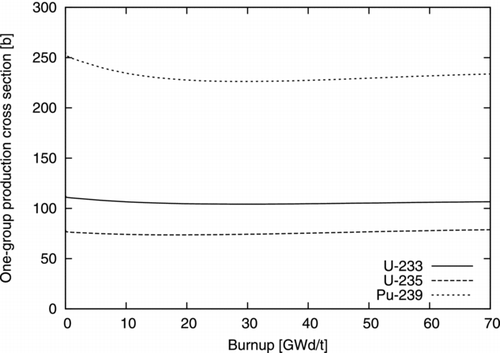
Table 2 Calculated neutronic parameters
4.1. Verification of sensitivity of burnup-related parameters
In order to verify the GPT-based sensitivity calculation capability of CBZ, sensitivities calculated with the GPT are compared with reference sensitivities, which are obtained by numerical differentiation in which a relative perturbation of 1% is given to a specific nuclear data parameter and change in the response neutronic parameter is observed. Comparisons are made for sensitivities of a critical eigenvalue and an ICR at EOC of the U cell to uranium-235 fission and uranium-238 capture cross sections. Results are shown in –. Sensitivities without the burup term are also shown to see the burnup effect on neutronic parameters at EOC. Sensitivities calculated with the GPT agree well with the references, and the GPT-based sensitivity calculation capability of CBZ is well verified. A positive effect of the burnup term observed in the sensitivity of a critical eigenvalue to the uranium-238 capture cross section can be easily understood in terms of the conversion of uranium-238 to plutonium-239. A negative effect of the burnup term is observed in the sensitivity of a critical eigenvalue to the uranium-235 fission cross section. The reason of this negative effect is explained from the power normalization effect: when a uranium-235 fission cross section is slightly increased, the neutron flux level decreases because of the fixed power rating, and the conversion of uranium-238 to plutonium-239 would be restricted. As a result, a critical eigenvalue becomes small.
4.2. Uncertainty quantification of neutronic parameters
Uncertainties of neutronic parameters of the four fuel cells are quantified using sensitivity coefficients calculated with the GPT and the JENDL-4.0 covariance data in a multi-group form. Relative standard deviations of neutronic parameters are summarized in and component-wise contributions are shown in for the U cell and for the U–Pu cell.
Table 3 Relative standard deviations of neutronic parameters (unit: %)
Table 4 Component-wise neutronic parameter uncertainties of the U cell
Table 5 Component-wise neutronic parameter uncertainties of the U–Pu cell
In the U cell, the uncertainty of the uranium-238 capture cross section is dominant in all the neutronic parameters. Uncertainties of the ν value (a number of neutrons generated by a fission reaction) of uranium-235 and χ (fission spectrum) of fissile nuclides are also dominant components. Uranium-238-induced uncertainty of the ICR at EOC is smaller than that at BOC due to cancellation in sensitivities of the ICR to the uranium-238 capture cross section between the static term and the burnup term, as shown in Figure .
In the U–Pu cell, it is a bit surprising to see that uncertainties induced by capture cross sections of high plutonium isotopes, plutonium-240 and plutonium-241, are dominant components in several neutronic parameters. shows relative standard deviations of capture cross sections of uranium-238 and plutonium-239, plutonium-240 and plutonium-241 in a 107-group structure. We can find that uncertainties of capture cross sections of plutonium-240 and plutonium-241 are much larger than the others. It should be noted that strong positive correlations are also given in capture cross sections of plutonium-240 below 8 eV and of plutonium-241 below 350 eV in the covariance matrix. The uncertainty of the CDR induced by χ of plutonium-241 is larger than that induced by χ of plutonium-239 since the plutonium composition changes through burnup. The plutonium composition at BOC is (Pu-238/-239/-240/-241/-242) = (0.02/0.56/0.26/0.10/0.07) and that at EOC is (0.04/0.41/0.29/0.16/0.09).
In the Th–U and Th–Pu cells, the uncertainty of the capture cross section of thorium-232 is a main contributor to uncertainties of all the neutronic parameters. shows energy-range-wise neutronic parameter uncertainties of the Th–Pu cell. We can find that the thorium-232 capture cross section uncertainty in the intermediate energy range from 78.9 eV to 86.5 keV is dominant in the neutronic parameter uncertainties and that in the thermal energy range is relatively small. It has been reported that the thorium-232 capture cross section uncertainty given in JENDL-4.0 is significantly larger than that given in ENDF/B-VII.1 even though the same resonance parameter set is adopted in both the evaluated data [Citation10].
Table 6 Energy-range-wise neutronic parameter uncertainties of the Th–Pu cell (unit: %)
– show the correlation among different neutronic parameters for each fuel cell. Strong correlations are observed between the same neutronic parameters at BOC and EOC. It suggests that uncertainties of neutronic parameters at EOC that are not measurable can be reduced by some technique if the parameter at BOC is measurable through reactor physics tests conducted in the start-up process. Furthermore, among the different kinds of neutronic parameters, relatively strong correlations are observed since the uncertainties of the same nuclear data, such as capture cross sections of uranium-238 and thorium-232, contribute to uncertainties of different neutronic parameters. Note that the correlation among neutronic parameters in the U–Pu cell is relatively weak in comparison with those in the other cells. This is because the main contributors to neutronic parameter uncertainties are slightly different among neutronic parameters in the U–Pu cell, as shown in Table . A weak correlation between the ICR at EOC and the coolant density-reduced reactivities at BOC and EOC in the Th–Pu cell is also notable. That comes from a difference in energy profile of sensitivity coefficients, as shown in .
Table 7 Correlation of neutronic parameter uncertainties of the U cell
Table 8 Correlation of neutronic parameter uncertainties of the U–Pu cell
Table 9 Correlation of neutronic parameter uncertainties of the Th–U cell
Table 10 Correlation of neutronic parameter uncertainties of the Th–Pu cell
5. Conclusions
The neutronic parameter uncertainty induced by nuclear data uncertainty has been successfully quantified for several light water reactor fuel cells composed of different combinations of fissile/fertile nuclides. The covariance data given in JENDL-4.0 have been used as the nuclear data uncertainty and uncertainty propagation calculations have been carried out using sensitivity coefficients calculated with the GPT for burnup-related neutronic parameters. The calculated sensitivity coefficients have been verified through a comparison with those obtained with numerical differentiation.
We have found that the main contributors of nuclear data uncertainty to the neutronic parameter uncertainty are the uranium-238 capture cross section in the U cell, plutonium-240 and plutonium-241 capture cross sections, and fission spectrum of fissile plutonium isotopes in the U–Pu cell. We have also found that thorium-232 capture cross section uncertainty is a dominant source of neutronic parameter uncertainty in the Th–U and Th–Pu cells and that the parameter uncertainties in the Th–U and Th–Pu cells are much larger than those of the other two. This quantitative uncertainty information can be a driving force for nuclear data experts to begin new measurements/evaluations. It should be emphasized that precise and detail information of component-wise uncertainties can be obtained by virtue of the adjoint-based sensitivity calculation methodology. Furthermore, cross-correlations have also been evaluated for each fuel cell, and strong correlations among the same parameters at BOC and EOC and among different parameters have been observed. This result is quite optimistic to introduce the uncertainty reduction technique, such as one proposed by Yamamoto [Citation12], for unmeasurable parameters using other measurable parameters.
Acknowledgement
This work was supported by JSPS KAKENHI Grant Number 24561040.
Notes
Note: Range 1: 78.9 eV–86.5 keV; Range 2: 0.6 eV–78.9 eV; Range 3: −0.6 eV.
References
- Chadwick , M B , Herman , M , Oblozinský , P , Dunn , M E , Danon , Y , Kahler , A C , Smith , D L , Pritychenko , B , Arbanas , G , Arcilla , R , Brewer , R , Brown , D A , Capote , R , Carlson , A D , Cho , Y S , Derrien , H , Guber , K , Hale , G M , Hoblit , S , Holloway , S , Johnson , T D , Kawano , T , Kiedrowski , B C , Kim , H , Kunieda , S , Larson , N M , Leal , L , Lestone , J P , Little , R C , McCutchan , E A , MacFarlane , R E , MacInnes , M , Mattoon , C M , McKnight , R D , Mughabghab , S F , Nobre , G PA , Palmiotti , G , Palumbo , A , Pigni , M T , Pronyaev , V G , Sayer , R O , Sonzogni , A A , Summers , N C , Talou , P , Thompson , I J , Trkov , A , Vogt , R L , van der Marck , S C , Wallner , A , White , M C , Wiarda , D and Young , P G . 2011 . ENDF/B-VII.1 nuclear data for science and technology: cross sections, covariances, fission product yields and decay data . Nucl Data Sheets , 112 : 2887 – 2996 . doi: 10.1016/j.nds.2011.11.002
- Shibata , K , Kawano , T , Nakagawa , T , Iwamoto , O , Katakura , J , Fukahori , T , Chiba , S , Hasegawa , A , Murata , T , Matsunobu , H , Ohsawa , T , Nakajima , Y , Yoshida , T , Zukeran , A , Kawai , M , Baba , M , Ishikawa , M , Asami , T , Watanabe , T , Watanabe , Y , Igashira , M , Yamamuro , N , Kitazawa , H , Yamano , N and Takano , H . 2002 . Japanese evaluated nuclear data library version 3 (revision-3): JENDL-3.3 . J Nucl Sci Technol. , 39 ( 11 ) : 1125 – 1136 . doi: 10.1080/18811248.2002.9715303
- Ishikawa , M . 2005 . “ Recent application of nuclear data to fast reactor core analysis and design in Japan ” . In Proceedings of the International Conference on Nuclear Data for Science and Technology (ND2004) , Santa Fe , , New Mexico : American Institute of Physics . Sep 26–Oct 1
- Sugawara , T , Nishihara , K , Tsujimoto , K , Sasa , T and Oigawa , H . 2010 . Analytical validation of uncertainty in reactor physics parameters for nuclear transmutation systems . J Nucl Sci Technol. , 47 ( 6 ) : 521 – 530 . doi: 10.1080/18811248.2010.9711974
- Shibata , K , Iwamoto , O , Nakagawa , T , Iwamoto , N , Ichihara , A , Kunieda , S , Chiba , S , Furutaka , K , Otuka , N , Ohsawa , T , Murata , T , Matsunobu , H , Zukeran , A , Kamada , S and Katakura , J . 2011 . JENDL-4.0: a new library for nuclear science and engineering . J Nucl Sci Technol. , 48 ( 1 ) : 1 – 30 . doi: 10.1080/18811248.2011.9711675
- Sugino , K , Ishikawa , M , Yokoyama , K , Nagaya , Y , Chiba , G , Hazama , T and Kugo , T . 2011 . Development of a unified cross-section set ADJ2010 based on adjustment technique for fast reactor core design . J Korean Phys Soc. , 59 ( 2 ) : 1357 – 1360 .
- Kodeli , I and Snoj , L . 2012 . Evaluation and uncertainty analysis of the KRITZ-2 critical benchmark experiments . Nucl Sci Eng. , 171 : 231 – 238 .
- Sakai , T , Shiba , S and Saitou , K . 2012 . Analysis of UAM benchmark problems (6) uncertainty analysis of core problems using stochastic sampling method . Atomic Energy Society of Japan. Proceedings of the 2012 Fall Meeting of the Atomic Energy Society of Japan , Japanese
- Oizumi , A , Yokoyama , K , Ishikawa , M and Kugo , T . 2012 . “ Uncertainty evaluation for MA production in spent light water reactor fuel with use of burnup sensitivity analysis ” . In Proceedings of the 2012 Annual Symposium on Nuclear Data (NDS 2012) Nov 15–16;. Forthcoming 2012.
- Kojima , T , Fujii , T and Kitada , T . 2012 . “ The validity of covariance data of 232Th in JENDL-4.0, ENDF/B-VII.1 and ENDF/Bi-VI.8 ” . In Proceedings of the 2012 Annual Symposium on Nuclear Data (NDS 2012) Nov 15–16; Forthcoming.
- Permana , S , Takaki , N and Sekimoto , H . 2007 . Feasible region of design parameters for water cooled thorium breeder reactor . J Nucl Sci Technol. , 44 ( 7 ) : 946 – 957 . doi: 10.1080/18811248.2007.9711334
- Yamamoto , A , Yasue , Y , Endo , T , Kodama , Y , Ohoka , Y and Tatsumi , M . 2012 . “ Uncertainty estimation of core safety parameters using cross-correlations of covariance matrix, In: American Nuclear Society ” . In Proceedings of the International Conference on Physics of Reactors (PHYSOR2012) Apr 15–20
- Kawano , T , Hanson , K M , Frankle , S , Talou , P , Chadwick , M B and Little , R C . 2006 . Evaluation and propagation of the 239Pu fission cross-section uncertainties using a Monte Carlo technique . Nucl Sci Eng. , 153 : 1 – 7 .
- Rochman , D , Koning , A J and van der Marck , S C . 2009 . Uncertainties for criticality-safety benchmarks and k eff distributions . Ann Nucl Energy. , 36 : 810 – 831 . doi: 10.1016/j.anucene.2009.01.018
- Abdel-Khalik , H S , Turinsky , P J and Jessee , M A . 2008 . Efficient subspace methods-based algorithms for performing sensitivity, uncertainty, and adaptive simulation of large-scale computational models . Nucl Sci Eng. , 159 : 256 – 272 .
- Williams , M L . 1986 . Perturbation theory for reactor analysis , Vol. 3 , Boca Raton , FL : CRC Press . CRC handbook of nuclear reactors calculations
- Williams , M L . 1979 . Development of depletion perturbation theory for coupled neutron/nuclide fields . Nucl Sci Eng. , 70 : 20 – 36 .
- Takeda , T and Umano , T . 1985 . Burnup sensitivity analysis in a fast breeder reactor – Part I: Sensitivity calculation method with generalized perturbation theory . Nucl Sci Eng. , 91 : 1 – 10 .
- Katakura , J , Kataoka , M , Suyama , K , Jin , T and Ohki , S . 2004 . A set of ORIGEN2 cross section libraries based on JENDL-3.3 library: ORLIBJ33 . Nippon Genshiryoku Kenkyujo , JAERI-Data, Code 2004-015. Ibaraki: Japan Atomic Energy Research Institute; (Japanese).
- Zhao , X , Pilat , E E , Weaver , K D and Hejzlar , P . 2000 . “ A PWR thorium pin cell burnup benchmark ” . In Proceedings of the International Conference on Physics of Reactors (PHYSOR2000) May 7–11
- 2002 . International Atomic Energy Agency , Vienna : International Atomic Energy Agency . (IAEA-TECDOC-1319). Potential of thorium based fuel cycles to constrain plutonium and reduce long lived waste toxicity
- Chiba , G . 2007 . ERRORJ: A code to process neutron-nuclide reaction cross section covariance, version 2.3 , Naka-gun , Ibaraki : Japan Atomic Energy Agency . (JAEA-Data/Code 2007-007).
- MacFarlane , R E and Kahler , A C . 2010 . Methods for processing ENDF/B-VII with NJOY . Nucl Data Sheets , 111 : 2739 – 2890 . doi: 10.1016/j.nds.2010.11.001
- Chiba , G . 2008 . CBGLIB: A multi-group neutron library for precise neutronics simulations , Naka-gun , Ibaraki : Japan Atomic Energy Agency . (JAEA-Conf 2008-008).
- Yamamoto , A , Tatsumi , M and Sugimura , N . 2007 . Numerical solution of stiff burnup equation with short half lived nuclides by the Krylov subspace method . J Nucl Sci Technol. , 44 : 147 – 154 . doi: 10.1080/18811248.2007.9711268
- Okumura , K , Kugo , T , Kaneko , K and Tsuchihashi , K . 2007 . SRAC2006: a comprehensive neutronics calculation code system , Naka-gun , Ibaraki : Japan Atomic Energy Agency . (JAEA-Data/Code 2007-004).
- Kawamoto , Y , Chiba , G , Tsuji , M and Narabayashi , T . 2012 . “ Validation of CBZ code system for post irradiation examination analysis and sensitivity analysis of (n,γ) branching ratio ” . In Proceedings of the 2012 Annual Symposium on Nuclear Data (NDS 2012) Forthcoming.
